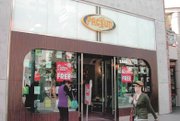New PacSun CEO Outlines Plans for Company Comeback
No one said turning around a retailer as big as Pacific Sunwear was going to be easy.
The Anaheim, Calif.–based mall retailer hired surfwear-industry veteran Gary H. Schoenfeld in July to steer the more than 927-store behemoth back to its place as one of the most popular shopping destinations for teen-agers aged 16 to 19.
Schoenfeld has his proverbial hands full. He not only had a weak economy to deal with, but his new employer also had not reported an increase in its sales since the third quarter of its 2007 fiscal year. Although the company’s results for the third quarter of its 2009 fiscal year were slightly better than Wall Street estimates, Schoenfeld had more poor financial news to report on Nov. 16 when he talked to retail analysts during a conference call on the company’s recent sales performance.
The retailer’s third-quarter net sales were $268 million, compared with $324 million for the same quarter during the previous year.
Its same-store sales declined 18 percent during the retail chain’s third quarter. It forecast a same-store-sales decline in the low 20 percent for the fourth quarter of fiscal 2009. Shares in the company tumbled more than 20 percent a day after the conference call. But retail analyst Liz Pierce said the retailer is on the right track to become a better competitor at the mall.
“[Pacific Sunwear] continues to be a work in process, and although it has hit some speed bumps as of late, we continue to believe the company is headed in the right direction,” she wrote in a Nov. 16 research note. Pierce works for Roth Capital Partners in Newport Beach, Calif.
During the conference call, Schoenfeld spoke frankly on the state of his company. “Pacific Sunwear has lost its way over the past hellip; almost five years,” he said. The retailer had ceased giving consumers merchandise that offered a real difference from its competitors, he said. He also briefly sketched out measures his management team would take to raise it out of its doldrums.
One big step would be changing its merchandising system and instituting a program to localize merchandising for its far-flung fleet of stores in 50 states and Puerto Rico. Stores will be able to focus on brands and products popular in the different regions where they are located. “We are missing sales, hurting our margins and damaging the customer experience by having too much of a one-size-fits-all [merchandise mix],” he said.
Lately, PacSun’s vendors have noticed a greater flexibility on the part of the store, according to Frank Delgadillo, founder of the Costa Mesa, Calif.–based fashion label Comune, which has been sold at PacSun.
“PacSun is rethinking who their consumer is,” Delgadillo said. “They’re a little more open to bringing more creativity to the floor. They’re positioning themselves to be a leader again.”
The retailer gave up too much market share to vertical retailers, Schoenfeld said. He planned to regain some of the lost position by offering more footwear, which many vertical retailers competing for the youth fashion dollar do not sell. By Spring, 300 stores will offer young men’s footwear, and 200 stores will offer juniors footwear.
Pacific Sunwear also will offer more of the brands that made it a destination for surf and skate styles. Schoenfeld pledged to find a better mix for its private-label products and branded products, such as Irvine, Calif.–based Billabong. However, he declined to state what that percentage would be.
Another measure will be to cut its fleet of stores. In the next three to five years, the PacSun fleet will be winnowed down to 750 to 800 stores. The retailer is in talks with many of its landlords, Schoenfeld said.
The retailer will fill five crucial positions that are empty now: general merchandising manager for juniors, head of stores, chief marketing officer, senior vice president of operations, and vice president of planning and allocation.
Despite the frank discussion over a weak sales performance, the company is financially strong. It ended its third quarter with $96 million in working capital and no borrowing on its credit facility.






















